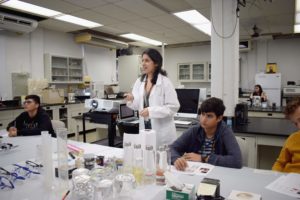
The National Science Foundation (NSF) has awarded grants to eight research teams to support partnerships that will increase diversity in cutting-edge materials research, education, and career development. One of those teams is Penn’s Laboratory for Research on the Structure of Matter (LRSM) and the University of Puerto Rico (UPR), whose long-running collaboration has now received an additional six years of support.
With the goal of supporting partnerships between minority-serving educational institutions and leading materials science research centers, NSF’s Partnership for Research & Education in Materials (PREM) program funds innovative research programs and provides institutional support to increase recruitment, retention, and graduation by underrepresented groups as well as providing underserved communities access to materials research and education.
‘Research at the frontier’
With this PREM award, known as the Advancing Device Innovation through Inclusive Research and Education (ADIIR) program, researchers from Penn and UPR’s Humacao and Cayey campuses will conduct research on the properties of novel carbon-based materials with unique properties, and will study the effects of surface modification in new classes of sensors, detectors, and purification devices.

Thanks to this collaboration of more than 20 years, both institutions have made significant scientific and educational progress aided by biannual symposia and regular pre-pandemic travel between both institutions before the pandemic, resulting in a rich portfolio of publications, conference presentations, patents, students trained, and outreach programs.
“Together we have been publishing good papers that have impact, and we’ve really cultivated a culture of collaboration and friendship between our institutions,” says Penn’s Arjun Yodh, former director of the LRSM. “Our goal is to carry out research at the frontier and, in the process, nurture promising students from Puerto Rico and Penn.”
Ivan Dmochowski, a chemistry professor at Penn who has been involved with PREM for several years, says that this program has helped his group connect with experts in Puerto Rico whose skills complement his group’s interests in protein engineering. Dmochowski has also hosted UPR faculty members and students in his lab and also travelled to Puerto Rico before the pandemic to participate in research symposia, seminars, and outreach events.
“I’ve had students who have benefitted from being a co-author on a paper or having a chance to mentor students, and the faculty we’ve interacted with are exceptional,” Dmochowski says. “There’s a lot of benefit for both me and my students, and I’ve enjoyed our interactions both personally and scientifically.”
Penn’s Daeyeon Lee, a chemical and biomolecular engineering professor who has been involved with PREM for several years, regularly hosts students and faculty from UPR while working on nanocarbon-based composite films for sensor applications. The success of this collaboration relies on unique materials made by researchers at UPR combined with a method for processing them into composite structures developed in Lee’s lab.
“What I really admire about people at PREM, both faculty and students, is their passion,” says Lee. “I think that’s had a really positive impact on my students and postdocs who got to interact with them because they got to see the passion that the students brought.”
Continue reading at Penn Today.
